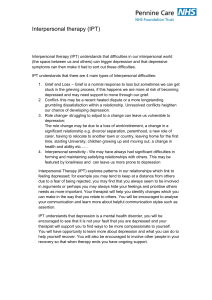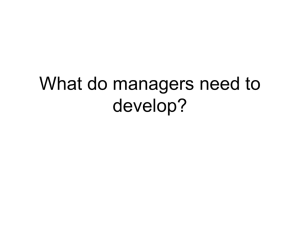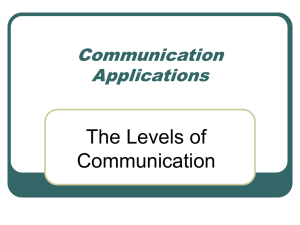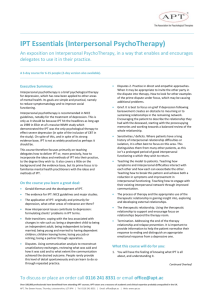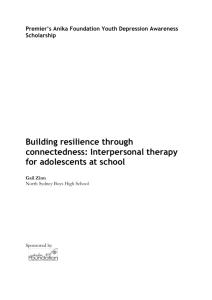That will
advertisement
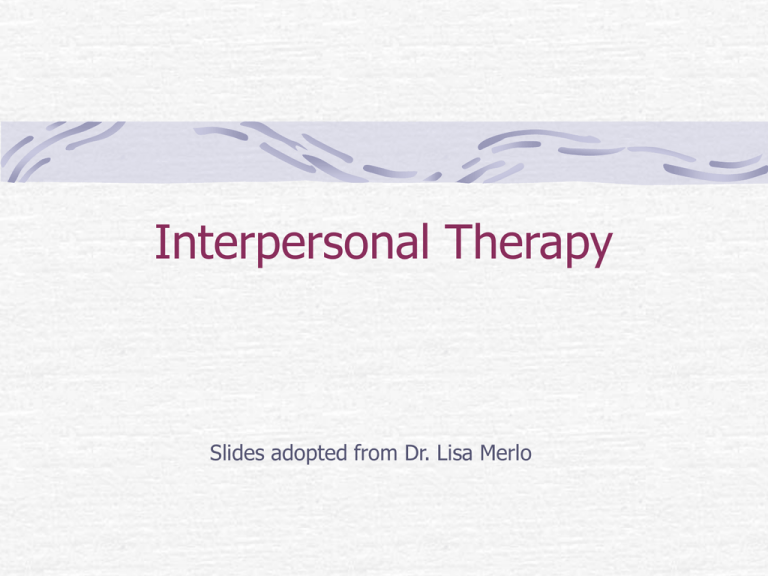
Interpersonal Therapy Slides adopted from Dr. Lisa Merlo Framework • A person’s behavior is viewed as influencing the reactions of people around them • The person’s typical “interpersonal style” may influence negative feedback from others, social isolation, relationship difficulties, etc. • These situational factors may lead the individual to become depressed Coyne’s Interpersonal Model of Depression • People who are depressed can be difficult to spend time with (e.g., they complain, they express negativity, they are less interested in participating in pleasurable activities) • Because of this, non-depressed people tend to decrease the amount of time spent with the depressed person Coyne’s Interpersonal Model of Depression • The depressed person experiences a lack of social support and a reduction in social interaction • This can lead the person to become more depressed • … which in turn makes them even less desirable to be around Clinical Application • Interpersonal therapy helps the patient to improve functioning, particularly in current relationships, in order to break the depressive cycle • Sessions focus on interpersonal style and interpersonal relationships Interpersonal Therapy • Interpersonal therapists focus on the functional role of depression rather than on its etiology or cause • They look at the ways in which problematic interactions develop when a person becomes depressed Goals of Interpersonal Therapy 1) To diagnose depression explicitly 2) To educate the patient and family about depression, its causes, and the various treatments available for it 3) To identify the interpersonal context of depression as it relates to symptom development 4) To develop strategies for the patient to follow in coping with the depression Interpersonal Therapy • In the first session, the psychiatric history includes a review of the patient's current social functioning and current close relationships, their patterns and their mutual expectations • Changes in relationships prior to the onset of symptoms are clarified, such as the death of a loved one, a child leaving home, or worsening marital conflict The “Sick Role” • The concept of the "sick role" is based on the notion that illness is not merely a condition but a social role that affects the attitudes and behaviors of the patient and those around him or her • Adolescent and parent(s) are informed that depression will limit the teen’s abilities to perform as well (to prevent excessive criticism) • Teens are encouraged to maintain participation in activities in order to help alleviate symptoms and prevent additional problems from isolation, etc. Areas of Focus • IPT is typically focused on 1-2 of the following problem areas: • • • • • Unresolved Grief Role Disputes Role Transitions Interpersonal Deficits Single Parent Families Adolescent Concerns • IPT attempts to meet unique developmental needs of adolescents • • • • • Individuating from parents Peer pressure Romantic relationships Experiences with death Issues of control/authority with parents 1. Unresolved Grief • In normal bereavement, a person experiences symptoms such as sadness, disturbed sleep, and difficulty functioning but these usually resolve in two to four months • Key factors to consider • • • • Teen’s social support system Teen’s place in family structure Psychosocial development Quality of the lost relationship • GOALS = • to facilitate the mourning process • help the patient re-establish interests and relationships that can begin to fill the void of what has been lost 2. Role Disputes • Interpersonal role disputes occur when the patient and at least one other significant person (usually parent) have differing expectations of their relationship • Keys factors to consider • • • • Identify disputes Negotiate options with parents Examine and change relationship expectations Clarify and alter communication styles • • • help the patient identify the nature of the dispute decide on a plan of action begin to modify unsatisfying patterns, reassess expectations of the relationship, or both • GOALS = Do not direct the patient to one particular resolution or attempt to preserve unworkable relationships 3. Role Transitions • Depression associated with role transitions occurs when a person has difficulty coping with life changes that require new roles (e.g., initiation of romantic relationship, transition to high school/college/work) • Role Transitions in depressed people: • Experienced as losses rather than opportunities • GOALS = • Help patient to give up the old role • Encourage expression of the accompanying feelings of guilt, anger, and loss • Elicit support and encouragement from parents • Facilitate acquisition of new skills • Develop a new social network around the new role 4. Interpersonal Deficits • Typically involves impairment in developmental tasks (e.g., making friends, beginning romantic relationships, forming social ties, making choices about romantic commitment, vocation, sexuality) • IPT helps teen identify specific role that deficits played in current & past relationships, consider what needs to be changed, and encourage those changes • Key factors to consider • Asking teens to practice new behaviors outside of therapy sessions • GOALS = • • reduce the patient's social isolation focus on the patient's past relationships, the present relationship with the therapist, and ways to form new relationships. 5. Single Parent Families • Severity typically depends on finality of the parent’s departure, abruptness of change, and whether the parent has left before • IPT helps with: • • • • Recognizing the impact of parent leaving Processing feelings of bereavement/rejection Processing hopes for continued relationship Facilitating effective relationship w/ remaining parent • Establishing relationship with absent parent • Understanding/accepting finality of the situation Inclusion of Parents • Parents are frequently included for part of treatment • Parents typically participate during initial psychoeducation sessions in order to learn more about depression and how it affects their child • Parents participate during middle sessions when the problem area involves the parent • Parents participate in termination phase to review: treatment progress, changes in family, planning for the future (e.g., continued treatment) Intervention Techniques 1) a focus on patients' emotions 2) an exploration of patients' resistance to treatment 3) discussion of patterns in patients' relationships and experiences 4) taking a detailed past history 5) an emphasis on patients' current interpersonal experiences 6) exploration of the therapist/patient relationship Distinctions Unlike other psychodynamic approaches, IPT: • Is brief (16 sessions) • Is focused (1-2 problem areas) • Emphasizes the ways in which a person's current relationships and social context cause or maintain symptoms • Does not explore the deep-seated sources of the symptoms • Views rapid symptom reduction and improved social adjustment as its goals • Frequently leads to more satisfying relationships in the present
